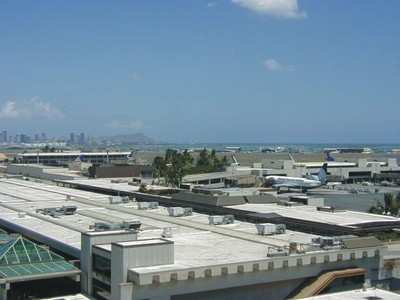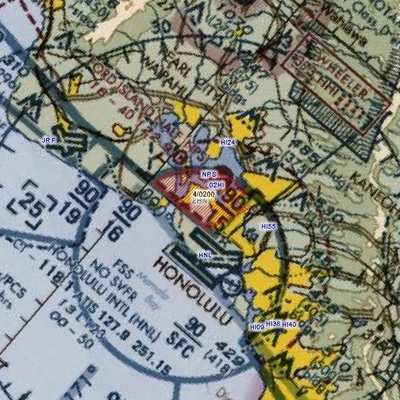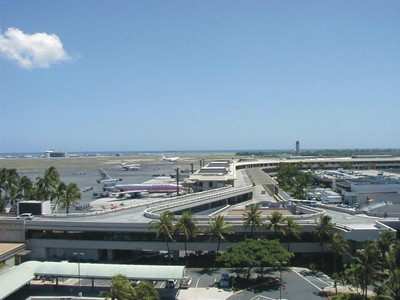Blame "Informal" Runway Program For Traffic Over
Neighborhoods
Residents of Hawaii's Ewa Beach are increasingly frustrated
about what they say is increasing noise levels from Honolulu
International Airport, especially at night, and they're letting
state and federal officials know.

At the heart of the growing controversy is not only the
increased number of lower flying jets, but a runway system that
seems to encourage such traffic over populated areas.
Aircraft flying into HNL are able to land on two runways: Runway
4 Right, which takes aircraft out over water, and Runway 8 Left,
which goes out over Kalaeloa and lower Ewa Beach and is the shorter
of the two runways, according to the Honolulu Advertiser.
The state Department of Transportation developed an "informal
runway use program," also known as the "preferential runway use
program" that requires all large, heavy and military turbo jets to
use Runway 4R between 7 pm and 7 am, away from residential
areas.
But there are some who believe pilots prefer to land on Runway
8L because it is shorter and uses less fuel. Pilots can request
Runway 8L at night by claiming "aircraft operational necessity,"
which is but one of several allowable reasons.
"If you're going to allow (a pilot), and he wants to go home,
sure he's going to use it," George Palfi, a Japan Airlines pilot
who lives in the affected area and flies into Honolulu several
times a month, said after a public meeting with state Department of
Transportation and Federal Aviation Administration officials last
week.
At the meeting, FAA and DOT officials declined to speculate
about why pilots would or would not request to use Runway 8L at
night, but would rather look at it from a safety
standpoint.

"The way I look at airport operations, we want to make it as
safe and efficient and effective as possible," said Jim Pratt, DOT
air site operations manager in Honolulu. "And if a pilot tells me
that he needs to - due to either an emergency or operational
necessity -- use a particular runway, I'm not going to second-guess
him."
Residents at the meeting said they want pilots to file a report
if Runway 8L is requested at night, according to Palfi. He said
there's no reason why Runway 4R can't be designated as the primary
runway.
Following the meeting, DOT spokesman Scott Ishikawa said his
agency is looking at placing more noise-measuring monitors under
the flight path and promised better communications with community
officials if something like an emergency happened that would
translate into increased use of Runway 8L.
Robert Rabideau, FAA air traffic manager in Hawaii, encouraged
legislators to see about the possibility of a noise compatibility
study of Runway 4R. He acknowledged planes may, indeed, be flying
lower than they used to.
Pratt agreed. "The answer to this question is the political
process," he said.
State Sen. Will Espero and Rep. Kymberly Pine told those at the
meeting they would seek congressional involvement.
FAA spokesman Ian Gregor said Friday while he did not have
numbers showing any recent change in Runway 8L usage, he did know
the number of flights in and out of HNL dropped from 414,000
annually in 1991, to 318,000 in 2006.
But Kiran Polk -- general manager of the Iroquois Point Beach
Club, a subdivision in the affected area -- disputed Gregor's
figures. She says the number Gregor cites do not consider how many,
when and the types of aircraft using each runway. She said the
government needs to also consider that of 1,463 rental units at the
former Navy housing development, 1,090 are now rented, and
indicating substantial area growth.

"I want them to stop flying Ewa Beach in the evenings," said
Pine, who complains of being frequently awakened by planes rattling
her Ocean Pointe home. "They wouldn't do it over Waikiki, so why
won't they do it for the people of Ewa Beach?" At the very least,
they should go back to higher flight patterns."
 ANN's Daily Aero-Linx (11.25.25)
ANN's Daily Aero-Linx (11.25.25) NTSB Final Report: Glasair GlaStar
NTSB Final Report: Glasair GlaStar ANN FAQ: Turn On Post Notifications
ANN FAQ: Turn On Post Notifications Classic Aero-TV: Red Tail Project Update Taking the Mission to the People
Classic Aero-TV: Red Tail Project Update Taking the Mission to the People Airborne 11.24.25: ANN's 30th!, Starships V3 Booster Boom, Earhart Records
Airborne 11.24.25: ANN's 30th!, Starships V3 Booster Boom, Earhart Records





